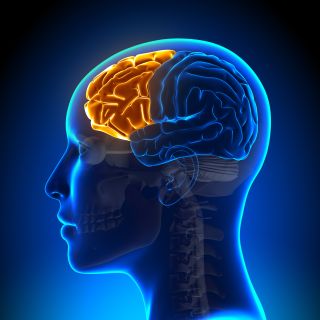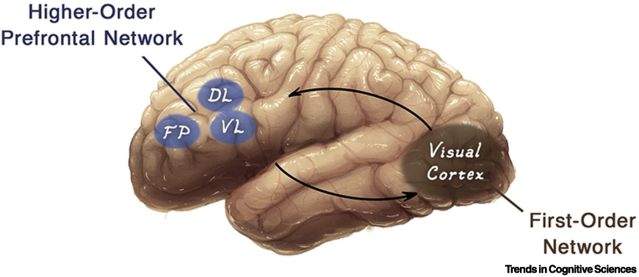NEUROSCIENCE- Understanding Higher-Order Theories of Consciousness. HOTs posit a possible way for the brain to render mental states conscious. Reviewed by Davia Sills

KEY POINTS-
- According to HOTs, consciousness arises when mental states are re-represented by higher-order mental states.
- This is thought to occur at higher levels of the brain, specifically in the prefrontal cortex.
- HOTs can explain certain characteristics of consciousness and arguably its subjective "qualia."

In this post, we will focus on higher-order theories (HOTs) of consciousness, one of several competing leading theories attempting to explain consciousness—or at least important aspects of its mechanism. There are a number of theories that fall within the HOT category. The discussion here will mostly pertain to the category as a whole rather than the particular differences between individual versions of the theory.1
First-order and higher-order mental states
According to higher-order theories, consciousness arises when a mental state is accompanied by a higher-order mental state that re-represents it (or reflects upon it, you could say).
As explained by Richard Brown, Hakwan Lau, and Joseph LeDoux, prominent proponents of HOT:
The basic idea, according to HOT, is that conscious experiences entail some kind of minimal inner awareness of one’s ongoing mental functioning, and this is due to the first-order state being in some ways monitored or meta-represented by a relevant higher-order representation.2
The lower-order representations, also referred to as first-order states, are primary mental states. They may include perceptions, thoughts, and emotions. The higher-order states are mental states that represent or reflect upon these first-order states. The higher-order states are thus meta-representations. According to HOTs, a first-order mental state becomes conscious because it becomes the focus of a specific type of meta-representation.
As Seth and Bayne explain in their “Theories of Consciousness” paper (which was cited in Part 1):
Meta-representations are not merely representations that occur higher or deeper in a processing hierarchy but are, rather, representations that have as their targets other representations. For example, a representation with the content ‘I have a visual experience of a moving dot’ is a meta-representation, for its content concerns the agent’s own representations of the world rather than the world itself.3
Here’s another helpful explanation from a different source:
Higher-order representations are ones that represent something about other representations, whereas first-order representations are ones that represent something about the (non-representational) world. This distinction can be applied to mental states. For example, a visual representation of a red apple is a first-order mental state, and a belief that one has a representation of a red apple is a higher-order mental state.4
The first-order mental states are usually representations of the external world. They originate mainly from sensory regions of the brain in the occipital, parietal, and temporal cortices, mostly located toward the back of the brain. The higher-order representations are thought to occur at higher levels of the brain, specifically in the prefrontal cortex, which is in the front (anterior) of the brain.5

A leading early proponent of higher-order theories is the philosopher David Rosenthal. The neuroscientist Joseph LeDoux, who himself has further developed HOT, explains Rosenthal’s basic idea:
The way to think about the difference between first-order and higher-order theory is in terms of the kinds of states involved: first-order theory focuses on a mental state that represents the world, while HOT adds an additional (higher) mental state that re-represents the sensory state. By definition, then, in HOT, the first-order state is a nonconscious one, and only becomes a conscious mental state with the help of a higher-order one. At the risk of over-simplification, the higher-order state makes conscious the lower-order one.6
HOTs can provide explanations for important characteristics of consciousness.
The various higher-order theories differ in how they explain the meta-representations that are responsible for consciousness. Some theories suggest that meta-representations are thoughts (or thought-like states) with conceptual content, while others describe them in computational terms.
HOTs also address why certain contents are conscious, and others are not. And they posit explanations for the distinct qualities of different conscious experiences, such as explaining why we apparently have an illusory impression of perceiving rich detail in our peripheral vision.
Can they explain qualia?
A very interesting and important question is whether or how HOTs explain the unique phenomenal character of various kinds of experiences, referred to as qualia. For example, the distinct, rich, qualitatively textured sensory difference between the subjective experience of seeing a sunset vs. having a headache. HOTs propose that the phenomenal character of a mental state depends on the properties attributed to the first-order state by the relevant meta-representational state.7 While most examples of this approach focus on visual experience, there are also attempts by HOTs to explain the phenomenal character of emotional and metacognitive states—such as “what it is like” to feel confident in a perceptual decision (metacognition is awareness and understanding of one’s own thought processes).
Function of consciousness
HOTs are not committed to any particular theory about the function of consciousness. Unlike many other theories, some HOTs do not attach importance to the idea that consciousness has any distinctive function. Others emphasize its role in metacognitive processes like confidence judgments and error monitoring. However, most HOTs don’t require conscious perception to always be accompanied by conscious metacognitive states. Instead, to be conscious, meta-representations themselves need to be the objects of suitable meta-representational states. As LeDoux explains:
One implication [of David Rosenthal’s version of a higher-order theory] is that we are not conscious of the higher-order state itself, only of the lower-order state. To become conscious of the content of the higher-order state requires that it be re-represented by an additional higher-order state. For example, HOT assumes that when we consciously see a red apple it is because the prefrontal cortex makes conscious the visual cortex’s representation of the visual properties of the object. To be aware that you are having the experience, an additional higher-order state, possibly also involving the prefrontal cortex, is needed.8
Evidence and challenges for HOTs
There is some supportive evidence for HOTs from studies that have pointed to anterior cortical areas, particularly the prefrontal cortex, being involved in conscious contents. Some of those studies have matched performance across conscious and non-conscious conditions. HOTs are also indirectly supported by evidence from brain lesions that have linked metacognition to prefrontal areas. However, HOTs are challenged by evidence suggesting that anterior areas are not involved in consciousness per se and, perhaps, instead, are necessary only for enabling subjective report and executive control.
Are only humans and a few other animals conscious? Or is there a more basic form of consciousness?
HOTs would seem to imply that only humans and a few other animals (perhaps some great apes) possessing well-developed frontal cortices are capable of consciousness. But it would seem more likely that there exist much more basic forms of rudimentary subjective experience—minimal or primary consciousness, present in a much wider array of animals, and that those basic forms of consciousness have become vastly elaborated in humans as higher forms of self-awareness. Some HOT theorists such as LeDoux have developed more complex, nuanced versions of the theory that are compatible with the possible existence in animals of “primitive states of unknowing (content-lacking) consciousness.” 9 As the evolutionary biologist Eva Jablonka and neurobiologist Simona Ginsburg state in their book describing their own theory of consciousness (called Unlimited Associative Learning), which is firmly grounded in evolutionary biology: “It is highly plausible that primary consciousness (human consciousness minus HOT) is present in all mammals.” 10
Consciousness explained or described?
The neuroscientist Michael Graziano, whose Attention Schema Theory of consciousness was listed in Part 1, argues that HOTs and several of the other theories of consciousness we will be discussing in this five-part series “are not trying to explain consciousness per se, as in qualia or subjective experience, but rather are trying to account for the mechanics of consciousness in the brain.” Graziano makes the point that this is simply “the approach inherited from the ‘neural correlates of consciousness’ (NCC) research program.” 11 As explained in Part 1, NCCs are the essential neural events needed to produce conscious states. They are correlations between brain activity and consciousness rather than explanatory links between neural mechanisms and aspects of consciousness—which is what theories of consciousness aspire toward.12
Graziano’s Attention Schema Theory was one of the theories mentioned in Part 1 in the category of “other strong contenders” for a theory of consciousness. Do some of those theories perhaps come a little closer to actual explanations of consciousness than the ones that are currently regarded as the leading theories (which are the focus of this five-part blog series)? Let’s examine the other leading theories before you decide.
- Questions and Answers
- Opinion
- Story/Motivational/Inspiring
- Technology
- Art
- Causes
- Crafts
- Dance
- Drinks
- Film/Movie
- Fitness
- Food
- Παιχνίδια
- Gardening
- Health
- Κεντρική Σελίδα
- Literature
- Music
- Networking
- άλλο
- Party
- Religion
- Shopping
- Sports
- Theater
- Wellness
- News
- Culture
- War machines and policy

